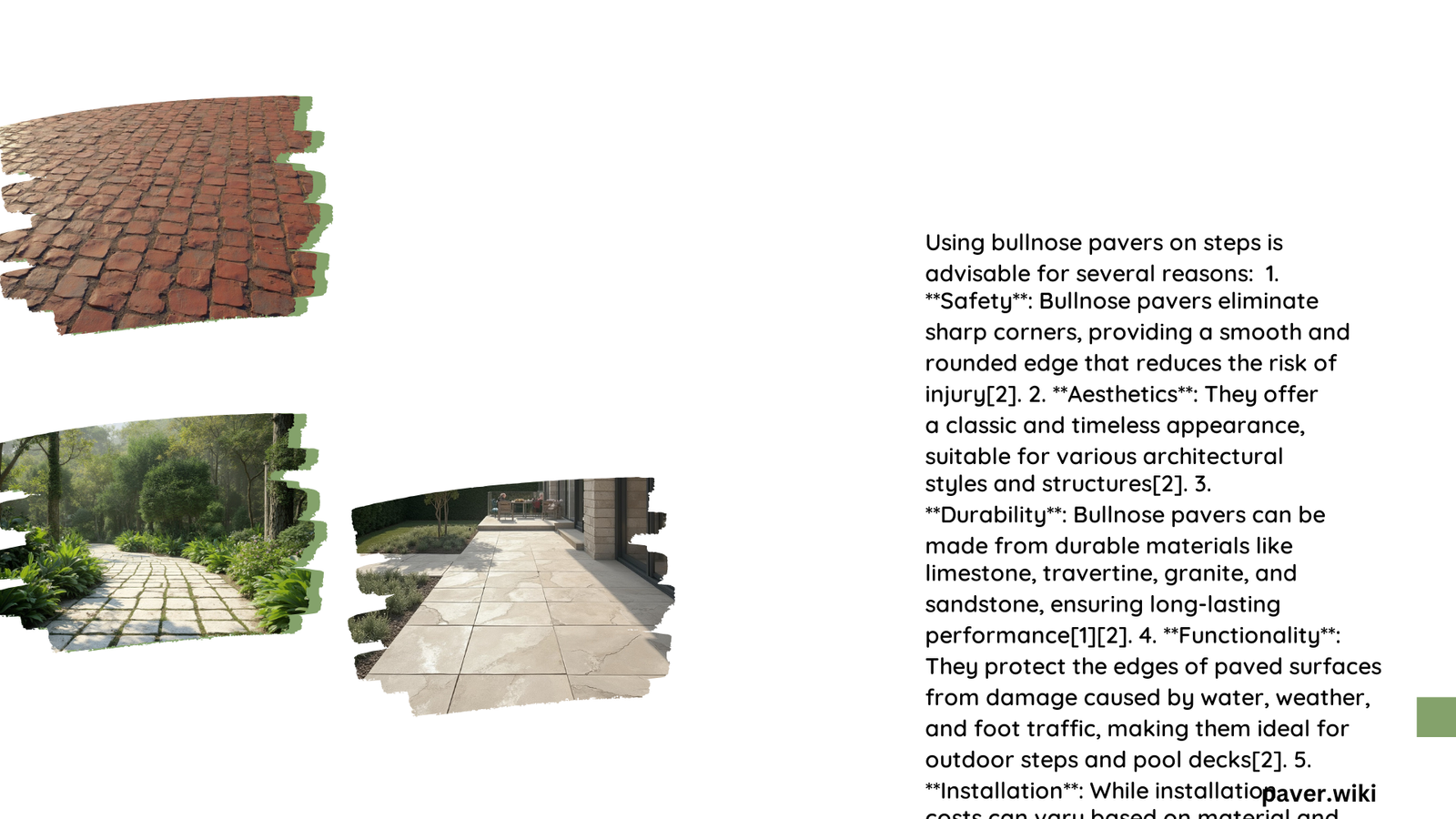Bullnose pavers are a popular choice for steps due to their rounded edges, which provide safety and aesthetic benefits. This guide explores the advantages, installation considerations, and cost implications of using bullnose pavers on steps. We’ll examine safety features, installation guidelines, and compare them to regular pavers to help you make an informed decision for your project.
What Are the Safety Benefits of Bullnose Pavers on Steps?
Bullnose pavers offer several safety advantages when used on steps:
- Elimination of sharp corners
- Reduced risk of accidents and injuries
- Smooth and comfortable surface
- Non-slip properties
The rounded edge of bullnose pavers is particularly beneficial in areas where people may walk barefoot or in wet conditions, such as around pools or outdoor staircases. This design helps prevent bruises and injuries from sharp edges, making it safer for people to touch and sit on.
Slip Resistance Features
While specific slip resistance ratings may vary by manufacturer, bullnose pavers generally offer:
- Textured surfaces for better traction
- Materials chosen for their non-slip properties
- Improved safety in wet conditions
These features make bullnose pavers an excellent choice for steps, especially in areas prone to moisture or frequent foot traffic.
How Do Bullnose Pavers Comply with Safety Standards?

Bullnose pavers are designed to meet various safety standards:
- Edge profiles conform to building codes
- Provide safe transitions between different levels
- Meet requirements for public and residential spaces
The rounded edge profile ensures a comfortable and safe transition, particularly important in areas like pool decks or outdoor staircases.
What Are the Installation Guidelines for Bullnose Pavers on Stairs?
Proper installation is crucial for the safety and longevity of bullnose pavers on stairs. Here are key guidelines:
Recommended Adhesives
| Adhesive Type | Characteristics |
|---|---|
| Polymeric Sand | Strong bonding, weather-resistant |
| Specialized Paver Adhesive | High-strength, suitable for heavy traffic |
Joint Spacing and Step Specifications
- Joint spacing: 1/8 to 1/4 inch
- Step height: 7-8 inches (rise)
- Tread depth: Minimum 11 inches
Always consult local building codes for specific requirements in your area.
How Do Bullnose Pavers Compare to Regular Pavers in Terms of Cost?
When considering bullnose pavers for steps, it’s important to understand the cost implications:
Material Costs
- Bullnose pavers are generally more expensive
- Example: Porcelain bullnose pavers cost around £30 per linear meter
- Natural stone bullnose pavers (e.g., granite, limestone) are pricier due to complex cutting and polishing
Labor Costs
Installation of bullnose pavers often requires:
- Higher precision in cutting and fitting
- Professional installation recommended
- Increased labor time due to complexity
Long-term Maintenance Considerations
Despite higher upfront costs, bullnose pavers offer:
- Increased durability
- Resistance to weather conditions and chemicals
- Reduced need for frequent repairs or replacements
What Are the Challenges in Installing Bullnose Pavers on Steps?
Installing bullnose pavers on steps presents several challenges:
Environmental Factors
- Exposure to sunlight, rain, and freeze-thaw cycles
- Need for materials resistant to fading and cracking
Substrate Preparation
Proper preparation is crucial:
- Level and compact the base
- Use a layer of compacted aggregate
- Add a sand bed for stability
Drainage Solutions
Effective drainage is essential:
- Slope the base away from structures
- Consider permeable materials
- Use additional drainage systems if necessary
How Do I Choose the Right Bullnose Pavers for My Steps?
Selecting the appropriate bullnose pavers involves considering:
- Material (concrete, natural stone, porcelain)
- Color and texture to complement your design
- Durability for your specific climate
- Non-slip properties for safety
Consider factors like foot traffic, weather exposure, and maintenance requirements when making your choice.
What Maintenance is Required for Bullnose Pavers on Steps?
Maintaining bullnose pavers on steps is relatively straightforward:
- Regular cleaning with mild soap and water
- Sealing to protect against stains and weather damage
- Periodic inspection for loose or damaged pavers
- Reapplying joint sand as needed
Proper maintenance ensures the longevity and safety of your bullnose paver steps.
In conclusion, bullnose pavers offer significant safety and aesthetic benefits for steps, despite higher initial costs. Their rounded edges, slip-resistant properties, and durability make them an excellent choice for many outdoor applications. Careful consideration of installation requirements and proper maintenance will ensure your bullnose paver steps remain safe and attractive for years to come.
References:
1. JS Brick Corporation – Bullnose Paver Coping: All You Need to Know
2. Eagle Pavers – All You Need to Know about Bullnose Paver Coping
3. Caledonian Stone – Porcelain Bullnose Steps & Copings : Everything You Need to Know
